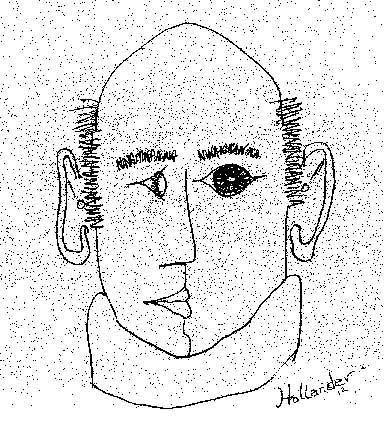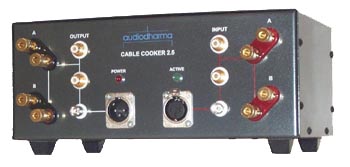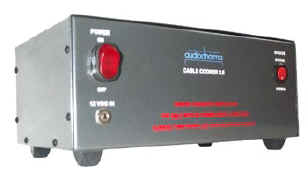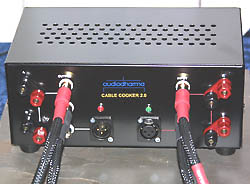|
You are reading the older HTML site
Positive Feedback ISSUE
15
The
audiodharma Cable Cooker™: Flooding With Signal - A Review
Product photos courtesy of Alan Kafton and audioexcellence az What's cookin', and why you should care If you are (like me) a guy who takes his car in for an oil change before he goes over the 3,000 mile recommended manufacturer's limit; or if you obsess over your car's performance and have to take it in for a tune-up long before it's due, then you'll love the audiodharma Cable Cooker™. If, on the other hand, you're the kind of guy (also, like me) who can't stand it when his expensive gear isn't running up to snuff and you suspect the interconnect cables, speaker cables, and AC cords are keeping your system from sounding its best, then boy have I got news for you. If you belong to neither of these categories, but you would like to find something that might improve your system (like me), kick it up a notch or two, without investing (very like me) in a major, and majorly expensive, overhaul—wait ‘til you read this. Before you plunk down your hard-earned cash for new cables, or new gear, you've got to hear what the Cable Cooker™ can do for you and your system.
What, you might ask, is it? A fair question. The Cable Cooker™ is a device that pushes a signal through your cables (interconnects, speaker cables, or AC cords) at hundreds of times the voltage and current levels than they're used to. The signal is a sweep tone, from the lowest lows to the highest highs (approximately 20 to 20kHz) that repeats and repeats, though not in your ear. Properly treated (read the instructions carefully) the results can be pretty sensational. All the various cables I've cooked have become (I imagine) more like the cable their designers imagined, have come to act more like the theoretical model as described in textbooks. For one example, we know that heating metals agitates the molecules and causes them to move around inside whatever physical structure they inhabit; wires, PC board traces, soldering tabs. The very process of soldering on the RCA jacks probably "deforms" (in the sense of "forming" a capacitor) the metals of an interconnect cables a significant amount. Cooking the cables corrects this "deforming" by a significant amount. Usually, how that subjectively translates is with cleaner, crisper, more vivid, more holographic sound reproduction with particular improvement in the upper and lower extremes of the audio range. Higher highs, Dudes, and lower lows. Well, maybe not exactly "more," but there is better definition, greater separation of instruments of differing timbre within the same register. Use your mentality and consider a piece of music where the bass viols, the celli, the organ, tympani and bass drum are all getting a workout, say, Fauré's Requiem. On "raw" cables, or before getting cooked, the various tones in this range (say 32Hz to 120Hz) can get a bit smudged together making it hard to separate one instrument from another. After cooking, the instruments stand out one from the other making it easier to follow what's going on. Wake up to reality in the treble region where, say, the cymbals, triangle, tambourine, and violins are all active separately and together, say, in Rachmaninoff's Symphonic Dances, the Cable Cooker™ cleans up the blurring and smearing. And if cooked cables clean up large orchestral works, they will equally well clean up jazz drumming, or bluegrass banjo picking, or Rock guitar solos, and (in theory) everything else. How it works - some speculation How does this happen? Consider the metaphor of a stream bed. According to my geologist friend, John Curl, during the dry season, what with erosion and the usual squalls and mid-sized storms, the water has to go over and around the rocks and boulders strewn randomly along the streambed. White water would be a crude measure of the rate of collisions. During the rainy season, what with large storms and perhaps even hurricanes, the water comes with such force (miles per hour) and volume (gallons per hour) that the rocks and boulders are pushed to the edges (or bottom) of the streambed creating for the most highly energized water a path of least resistance. Similarly, during routine use, even playing music loudly, the cables of the average system have randomly arranged crystals of metal in the path of the electrons causing collisions at a certain rate. The increased or decreased rate of collisions is inferred from the measurement of lost percentage in the ideal propagation velocity, expressed as percentages of the speed of light. During cooking, which is analogous to "flooding," the signal comes with such force (voltage) and volume (amperage) that the molecules are pushed into alignments that create a path of least resistance, from RCA plug IN to RCA plug OUT, causing collisions at a much reduced rate. I must plead ignorance of anyone's measuring the propagation velocity in an interconnect before and after cooking the cable. But, according to my ears, there is a difference, and the analogy works for me. We've all noticed that an ice cube enlarges in the tray compared to its liquid form. This is because the molecules, while freezing, align in a crystalline formation. The same thing is true of molecules of metals. When metals are "frozen," or taken to temperatures approaching absolute zero, the molecules also align in crystalline formation. Silver solder is said to "form" into a more advantageous series of "tunnels" than regular lead/tin solder when it changes state from molten liquid to crystalline solid. When various metals have achieved this crystalline "tunneled" state, electrons can zip through the wires at greatly increased speed, due to minimal collisions, and this phenomenon has been used to good effect to study and implement super-conductors. Since the work on super-conductors, we've come to recognize that annealing metals by subjecting them to extremes of temperature (either hot or cold) makes sonic changes by forcing the molecules into various crystalline formations. We can see how cable-cooking is based in similar theory. The as-yet-untested hypothesis is: The signal is able to traverse the length of the cooked cable with fewer collisions than in untreated (raw) cables. Handling the cost, and re-treatment The Cable-Cooker doesn't require the capital-intensive and time-consuming Cold Rooms that super-conductors require. I'm told it takes one week to incrementally get objects in the Cold Room to their coldest, about a week in that environment to get the cables in question to chill out, and another week to incrementally raise the temperature of the cables back to normal. The good news is that you don't have to put up with all that, and you don't need to have a massivo budget to acquire the benefits of cable cooking. The Cable Cooker™ itself costs less than many of the top flight cables cost. The Cooker requires minimal monitoring. It achieves its end in a matter of days (sometimes hours) instead of weeks. And it provides much of the same benefits as cryogenic treatment (aligning the metal molecules) though by less extreme means. Even skeptics I've introduced to the world of the Cable Cooker™ agree, "It works!" And, relative to cryogenic treatment, when the cost of a Cable Cooker™ is shared by a local group of audiophile buddies, it's quicker and cheaper than doing the cryo frosty freeze on your wires. Interestingly, after three or four months of use (your mileage will vary), the cooked cables seem to drift slowly back to near their usual "raw" state, sounding less vivid. For optimum results, the Cable Cooker™ would have to refresh cables every so often. For the audiophile who can own a Cable Cooker™, this is a small concern because he can daisy chain about three sets of interconnects per session and refresh his most used cables whenever he likes in about twenty-four hours. For audiophiles without deep pockets the Cable Cooker™ might be the answer for an Audiophile Club, or a reason for starting one (formal or informal), where the expense can be shared. Each member could schedule his use at regular intervals. It would take a membership of 90 to rotate through a three month cycle.
Various cables in a system handle differing signal strengths: the phono cables, from the tone arm to the pre-amp, routinely handle the millivolts of signal; the line level interconnects from, say, the CD player to the pre-amp, handle the next least, from small fractions of a volt to an upper limit of two volts; loudspeaker cables, from the amp to the speaker, sometimes handle considerable amounts of current; and the AC cords, from the AC source to the gear, can handle amounts mimicking air-conditioners. The lowest level (phono and line-level) cables benefit most from cooking. The loudspeaker cables benefit less. And the AC cords (especially to the amps) benefit relatively least. I'm not sure, but intuitively it seems the phono interconnects never get a chance to "form" as they see such low voltage and current. Cooking them yields a significant result. The AC cord to a Class A power amplifier might draw as much current as a refrigerator-freezer, and so it probably gets "formed" pretty well in normal use. Close behind AC cords, I'd say, come loudspeaker cable, because loud playing gives them a good chance to "form." Again, the interconnects achieve greater vividness, especially at the upper and lower octaves of the audio bandwidth. I experienced that as greater separation of instrumental timbre, and separation of instruments in space. All together the impression is one of greater clarity of sound, with a larger sound field. Cleaner cleans, Dudes, and deeper deeps. Loudspeaker cables have to be treated longer and they yield a subtle, but noticeable, increase of the same characteristics as the interconnects. More of the same. AC cords have to be treated longest for the subtlest return. Also, more of the same, and in smaller quantities, but noticeable by the discerning Dude. I guess there is a caveat here: High resolution systems benefit a good deal. Low resolution systems won't be able to capture what's going on. Good mid-fi systems might be large benefactors with one pair of interconnects to the CD player, and one pair of loudspeaker cables. And I got a startlingly good kick up a notch when I cooked the cables in my multi-channel surround sound system. That really perked things up a good bit. Furthermore, much of what I thought was poor execution of design, or mistakes in manufacture, or bad matches between my system and various "raw" cables, seemed to go away once the cables were cooked. In some sense the cables came more to sound like each other. So, you might say, the cables all began to perform closer to their design concept of ideal. I can understand why engineer types for so many years have said, "Cables are cables. They should all sound alike." It seems the benefits of careful handling, dressing, roping, filament thickness ratios, careful metallurgy, insulation materials, termination materials, are all undermined by the process of soldering and the effect it can have on the metals. The Cable Cooker™, I believe, corrects this damage. I think no audiophile, or audiophile club, should be without one. I'm not kidding. Would you hesitate to own the latest and greatest breakthrough in cable technology? This may be it. If you'd like more information, especially frequently asked questions and answers, you might go to http://www.audioexcellenceaz.com and surf around until you find the Cable Cooker™ and the section of the website dedicated to it. I have met Alan Kafton, the Big Daddy of cable cooking, at a recent audio show, and he seemed like a real nice dude. He's really into this offshoot to audio technology, but he's also a retailer who's forced to know a lot about all phases of sound reproduction. He has my confidence. Check him out. For the record - what I "cooked" The cables I "cooked" were Goertz Alpha-Core, silver and copper, interconnects and speaker cables; Harmonic Technology, silver and copper, interconnects, speaker cables, and AC cords, Twister Pair Designs, copper interconnects, speaker cables, and AC cords; and Silver-Fi silver interconnects. I was able to cook one and A/B test against the remaining "raw" cables of the same make and manufacturer. I have renewed respect for all of these cables, once cooked. My complex system, now featuring a Shadow electronic crossover, and a (for review) Rives parametric equalizer, in addition to my regular (highly modified) Mark Levinson JC-2 pre-amp, Parasound Halo JC-1 amps, Marantz 8260 SACD multi-channel CD player, Monster Automatic Voltage Stabilizer (AVS 2000) and Monster Home Theatre Reference Power Center (HTS 7000), VPI HW.4 turntable, Souther-Clearaudio linear tracking tone-arm, and top of the line Grado Master Statement cartridge LP front end, has many interconnect cables. Even my speakers have to have separate (100Hz and down) woofer cables and (100 Hz and up) tweeter cables. My more or less home brew speakers have never sounded better. I mean, I've been able to voice my system as never before with cooked cables in selected spots until it is nearly exquisite. I say this as someone who's been privileged to listened to J-10's system, and to many other high class systems in the better Audio boutiques in my (Baltimore-Washington) area, and at the shows. The Cable Cooker™ has inched me further toward the ideal of "live, acoustic music, in the room." Conclusion The Cable Cooker™ has brought an added degree of clarity to my system that creates a better facsimile of having the musical event in the room. This is especially true of intimate jazz combos, small folk ensembles, classical string quartets, human voices (male and female); it also grants me a closer look at the intricacies of complex classical music. I'm not saying it changed my chicken droppings into chicken salad. My big system was pretty good before cable cooking came along. But I am saying that the Cable Cooker™ allows for greater resolution and sharper focus without being obtrusive. I don't know if I'll be able to live without it. Just for fun, I dropped a couple of cables on an audio buddy, whose wife calls him "Pooh Bear." Pooh has a modest system. I brought him two pair of identical interconnects that came with my Marantz SACD player, one "cooked," one "raw." After anticipating he'd say all my enthusiasm was smoke and mirrors, he finally had to concede that there was a significant difference. Pooh said listening made a believer out of him, and he was a man of science who ran an important lab during his professional career. His parting shot was, "I still have to see a photo from an electron microscope, and propagation velocity data from a reputable lab." Like Othello, he has to have ocular proof. I'm not sure how you could get samples from a "cooked" wire without "deforming" it. I'll have to think about that. Summing up: The Cable Cooker™ can transform entry level interconnects to surprisingly good ones, medium speed cables to real good, and excellent cables to breathtaking. This item should be standard equipment for anyone who sells or manufactures audio cables. It should be standard for recording studios, or bands with lots of mixers and microphone cables. And it should be standard for anyone who has a big bucks invested in a primo system. Trust me. If you can't justify the price ($650 for "Standard" model; $779 for "Pro"), talk a buddy or two into coming in as partners. You'll all be glad you did. Ciao, bambini.
Alan Kafton
audiodharma Cable Cooker™ info page: http://www.audioexcellenceaz.com/audiodharmacablecooker.htm
|



 Categories of cables
Categories of cables